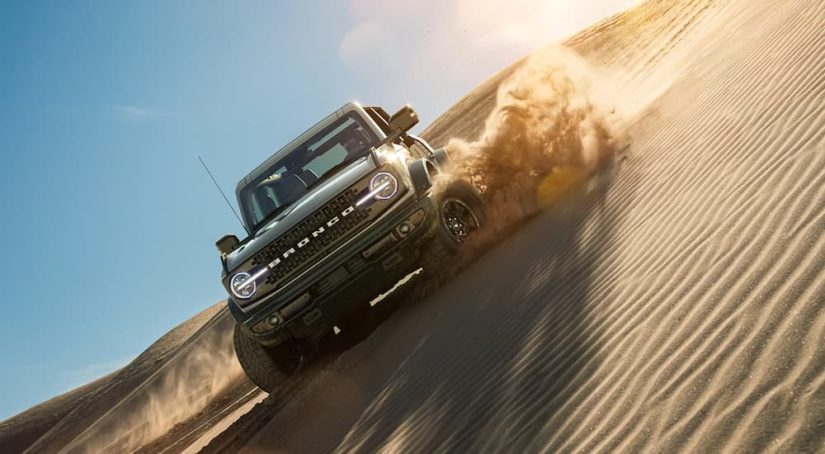Perhaps you live in a northern state where snow and ice is a daily occurrence for what seems like half the year. Perhaps you like to spend your free time driving down fire roads looking for the perfect place to enjoy the great outdoors. Or perhaps you simply need a reliable vehicle that you can trust not to get stuck when you travel to job sites or get around the farm. Whatever the reason, a simple front-wheel drive or rear-wheel drive model isn’t enough. You need a vehicle that can send power to all four wheels and keep moving forward no matter what gets in your way. The only problem is, you’re not sure what’s the difference between all-wheel drive and four-wheel drive, and you don’t know which one is right for you.
Don’t worry. The good news is that CarBuyerLabs is here to answer your questions and help you get behind the wheel of a truck or SUV that can meet your expectations for bad weather and all-terrain performance. Unfortunately, the bad news is that the subject of all-wheel drive and four-wheel drive is a complicated one that will take a while to explain. So sit back, relax, and get ready to learn everything you never knew you needed to know about the mechanics of delivering power to four wheels.
The Short Explanation
For those of you with places to be who don’t have the time to sit around for the long explanation, here are the basics. All-wheel drive is always active and is better for drivers who want to deal with bad weather on paved roads. Four-wheel drive needs to be manually engaged and won’t save you if you start slipping suddenly, but if it is engaged, it will provide superior traction to all-wheel drive. Auto manufacturers understand that the two systems are best suited to different use cases, and they generally put the appropriate system in the right vehicle. Most SUVs (and the handful of sedans that offer it) come with some form of all-wheel drive, while most trucks come with a version of four-wheel drive. In short, don’t worry too much about it, and as long as you aren’t planning anything too crazy, you probably won’t notice much difference between the various options anyways.
The Long Explanation
Not satisfied with the short explanation? Good. Because now we are going to dive into all the details. The first thing we have to get out of the way is that “four-wheel drive” and “all-wheel drive” are two monolithic entities, they’re not. They’re actually more of an overlapping Venn diagram. However, there is one single mechanical feature that distinguishes them. True four-wheel drive locks the front and rear axles together, forcing them to turn at the same rate. All-wheel drive sends power to both axles, but they can turn at different speeds. This difference is what gives four-wheel drive its superior traction and gives all-wheel drive its friendlier high-speed performance.
To understand why this difference is so critical, you have to understand a bit about how drivetrains work. Getting power from the engine to the wheels is complicated and requires a lot of gearing to redirect power in the right directions. This includes the use of differentials on the powered axles. A differential is a special piece of gearing that can split and redirect power while allowing some flexibility so that different parts can turn at slightly different speeds––a necessary feature to accommodate turning and corners, but a fatal flaw in bad conditions.
A standard “open” differential allows power to follow the path of least resistance, which means that if one wheel loses traction in a two-wheel drive car, that wheel gets all the power, spinning uselessly while the wheel with traction remains stationary. However, if you can “lock” the differential, it will split power evenly and force both wheels to turn at the same rate. In four-wheel drive and all-wheel drive vehicles, there are three differentials: one on each axle and one in the center. A locking center differential distinguishes a four-wheel drive vehicle from an all-wheel drive model, although most vehicles of both types still have open front and rear differentials.
![]()
We’re Not Done Yet
Note that we said “most vehicles”––this is where things get tricky when comparing four-wheel drive and all-wheel drive. Depending on exactly what types of differentials a manufacturer chooses to use, there is a lot of overlap in actual performance. While your standard four-wheel drive pickup truck with open front and rear differentials and a manually-locking center differential will outperform your standard crossover SUV with open front and rear differentials and a computer-controlled clutch pack center differential, things get more complicated when you start talking about higher-end vehicles.
For instance, the new Ford Bronco Sport Wildtrak uses a computer-controlled clutch pack for the center and rear differentials, allowing it to send power individually to three of its four wheels, while your standard pickup can only assure that power is getting to two of its four wheels. Of course, at the top of the line, you have vehicles like the iconic Jeep Wrangler Rubicon, which boasts front, rear, and center manually-locking differentials, guaranteeing that all four wheels are rotating at the same speed. Remember what we said about Venn diagrams? This is why. If you want to know how a particular vehicle will perform, you need to know all the details of its drive train, not just simply whether it has four-wheel drive or all-wheel drive.
There is also one other feature that four-wheel drive often has that is not generally found in all-wheel drive: a transfer case. Unlike a simple differential, which merely connects the front and rear axles, a transfer case can also have high and low gear ranges, almost acting as a secondary transmission. As a quick reminder, low gears have a higher gear ratio, multiplying the torque supplied by the engine but limiting top speed. A “4Lo” setting effectively puts the vehicle in an ultra-low gear, providing tremendous torque in low-speed situations. The Wrangler Rubicon’s Rock-Trac four-wheel drive system, for example, has an extremely low 4:1 gear ratio, giving it a total gear ratio of 84:1. That’s a lot of torque, even if it limits the vehicle to 25 mph when engaged.
Manufacturers Lie… A Lot
Now that you know the mechanical difference between four-wheel drive and all-wheel drive, you may have realized that some vehicle ads and spec sheets were not being entirely truthful. There are a ton of models out there that are advertised as having four-wheel drive when they are actually equipped with all-wheel drive because of the perceived superiority of four-wheel drive. Jeep is a particularly bad offender here, calling all of its systems “4×4” even when most of them are clearly all-wheel drive (if you are a shopping for a Jeep, the only true four-wheel drive systems are found on the Wrangler and Gladiator, although its all-wheel drive systems are far more advanced than most competitors).
However, there are even some four-wheel drive systems that are advertised as all-wheel drive because it makes more sense for the segment that they are in. The Subaru WRX STI sports car, for instance, has a “Driver Controlled Center Differential.” This is a fancy name for manually-selectable four-wheel drive (although switches between all-wheel drive and four-wheel drive rather than having a two-wheel drive mode like traditional four-wheel drive vehicles). Audi even went further, with some of its older Quattro all-wheel drive cars offering manually locking center and rear differentials, providing similar traction to an off-road truck. The lesson here is, again, the only way to know what sort of four-wheel capabilities a particular vehicle offers is to do your research on it rather than simply seeing “all-wheel drive” or “four-wheel drive” on the brochure and making assumptions.

When the Rubber Meets the Road (or Trail)
We’ve covered a lot of mechanical details here, so it’s about time to zoom out and take a look at what all of this actually means. The single most important difference between all-wheel drive and four-wheel drive is that all-wheel drive is always active. That means if you are cruising along and hit a slippery stretch of road, your car will automatically send traction to the wheels that need it, leaving you to focus on steering. If you are driving a four-wheel drive vehicle and hit a slippery patch, you had better hope that you already have four-wheel drive engaged, or you will be effectively stuck with a two-wheel drive car until you have the chance to switch to four-wheel drive (some manufacturers are starting to build four-wheel drive systems with an automatic setting, but these are still few and far between).
The second most important difference is that all-wheel drive usually doesn’t hold up as well to heavy use. If you get stuck driving through deep mud or rock crawling, it is possible to overheat the clutch packs in a standard all-wheel drive system. While modern systems are usually designed to disengage before they damage themselves, this still leaves you stuck as your all-wheel drive will stop working until it has a chance to cool down. This is why you rarely see all-wheel drive on anything designed for serious off-road performance.
Which is Better? All-Wheel Drive or Four-Wheel Drive
If you have made it this far, then you know why there is no easy answer to this old question. Which is better really depends on how the vehicle is designed and what you intend to do with it. Fortunately, as we mentioned in the short explanation, manufacturers are pretty good about designing drivetrains that match the vehicles they are installed in. Most of the crossover SUVs and pickup trucks on the road have a relatively straightforward all-wheel drive or four-wheel drive system that was designed primarily for affordability and efficiency, but that will get you out of any reasonable trouble you will find yourself in. However, if you often find yourself pushing the limits of what your vehicle should be used for, then a performance-oriented model will generally offer an upgraded drivetrain with additional features designed to improve your traction on the road. If you are looking to go fast, then that system will likely be branded “all-wheel drive,” and if you are looking to wade through mud and climb rocks, then that system will likely be branded “four-wheel drive.” But whatever the name, it will likely be well designed for the intended task.



